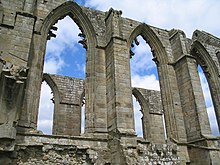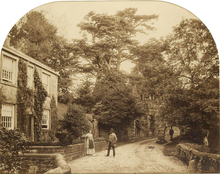Bolton Abbey


Bolton Abbey is the estate within which is located the ruined 12th-century Augustinian Bolton Priory in North Yorkshire, England. It gives its name to the parish of Bolton Abbey.
Bolton Priory

The monastery was originally founded at Embsay in 1120. Led by a prior, Bolton Abbey was technically a priory, despite its name. It was founded in 1154 by the Augustinian order, on the banks of the River Wharfe. The land at Bolton, as well as other resources, were given to the order by a Lady Alice de Romille of Skipton Castle in 1154.[1] In the early 14th century Scottish raiders caused the temporary abandonment of the site and serious structural damage to the priory.[2] The seal of the priory featured the Blessed Virgin Mary and the Child and the phrase sigillum sancte Marie de Bolton.[3]
The nave of the abbey church was in use as a parish church from about 1170 onwards, and survived the Dissolution of the Monasteries.
Building work was still going on at the abbey when the Dissolution of the Monasteries resulted in the termination of the priory in 1539. The east end remains in ruins. A tower, begun in 1520, was left half-standing, and its base was later given a bell-turret and converted into an entrance porch. Most of the remaining church is in the Gothic style of architecture, but more work was done in the Victorian era, including windows by August Pugin.
Bolton Abbey Estate
The Bolton Abbey Estate formerly belonged to the Dukes of Devonshire until a trust was set up by the 11th Duke of Devonshire turning it over to the Chatsworth Settlement Trustees to steward. The 12 000 hectare/30 000 acre/120 km². Estate has five areas designated as Sites of Special Scientific Interest, including Strid Wood, an ancient woodland (mainly oak), which contains the length of the River Wharfe known as The Strid.
The Embsay & Bolton Abbey Steam Railway currently terminates at Bolton Abbey station one and a half miles/2.5 km from Bolton Priory.
Bolton Abbey in popular culture
The remains of the priory can still be seen, and the setting is immortalised in both in art and poetry. These include a painting by Edwin Landseer and watercolours by J. M. W. Turner one of which, Bolton Abbey, Yorkshire (1809), is held at the British Museum.[4] William Wordsworth's poem The White Doe of Rylstone was inspired by a visit to Bolton Abbey in 1807.[5] In episode 6 of the BBC series The Trip, Bolton Abbey is visited[6]. A blurred photo of the Abbey is on the cover of Faith by The Cure, an album from 1981.
Gallery
-
Walker's view of Strid
References
- ^ Bolton Abbey - Priory Ruins
- ^ Brabbs, Derry: "Abbeys & Monasteries", pages 82-83, Weildenfeld & Nicolson, 2003.
- ^ Houses of Austin canons - Priory of Bolton | British History Online
- ^ Turner's painting at the British Museum
- ^ Rare Wordsworth Manuscript Secured By Wordsworth Trust - 24 Hour Museum - official guide to UK museums, galleries, exhibitions and heritage
- ^ Plot summary on IMDb








